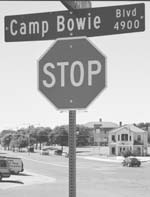|
Thursday,
October 18, 2001
Camp
Bowie’s brick street considered landmark in Fort Worth
By Laura McFarland
Staff Reporter
Shops
and homes on either side of the boulevard bustle with activity.
The old-fashioned streetlights give off a warm glow, and the
bump, bump, bump of cars driving on the vintage bricks of
Camp Bowie Boulevard fills the air.
The stretch
of Camp Bowie Boulevard that runs from Arch Adam Street to
Merrick Street is one of the few streets in Fort Worth that
is still paved with the bricks that were so popular in the
1920s and 1930s.
The traditional
elements that Camp Bowie Boulevard brings together help make
it a Fort Worth landmark, said Marty Craddock, Historic Camp
Bowie, Inc. board member.
“Even though it’s bumpy at times, it’s a wonderful
asset,” Craddock said. “It’s genuine, has character
and is not found in any other place in the city.”
 |
|
Laura
McFarland/Skiff Staff
|
Quentin
McGown, general council at Texas Wesleyan University, said
the bricks that have lasted almost 80 years on Camp Bowie
Boulevard were manufactured in Thurber, Texas in the 1920s.
“While
they were doing the coal mining and excavating for oil, they
found this incredible red clay,” McGown said. “They
began manufacturing millions and millions of bricks.”
Most
of the bricks survived until the 1960s, when Fort Worth began
moving toward more modernization.
“The
city was trying to move away from the Cowtown image,”
McGown said. “Brick was a wonderful solid surface. As
the technology was changing, the city found it easier to just
pour on a new street than to keep on repairing the brick.”
In many
instances, concrete was simply poured over the existing brick
road rather than pulling it up.
Those
few streets that did survive are so unique and full of personality
that they must be preserved, McGown said.
The property
owners on Camp Bowie Boulevard are so dedicated to safeguarding
the area they started Historic Camp Bowie, Inc. in 2000. The
non-profit organization was established to help beautify and
revitalize the historic street.
“I’m
tickled to death we have the organization because they’re
working hard to increase the vibrancy of the street,”
Craddock said.
Brandy
O’Quinn, president of Historic Camp Bowie, Inc., said
the organization plans to eventually restore the brick along
the entire length of Camp Bowie Boulevard.
Even
the parts of the boulevard that are concrete have the original
brick underneath.
“What
we want to do is strip the asphalt off the brick. It’s
a very difficult, labor-intensive process,” O’Quinn
said.
In October
2000, 58 percent of the property owners also created a “Public
Improvement District.” This allows property owners to
assess an extra tax to use for specific improvements in their
area, O’Quinn said.
“We
feel it’s very necessary to not just maintain the boulevard,
but to create an experience for people who come down to Camp
Bowie,” O’Quinn said.
Debe
Williams, a bartender at Rick’s on the Bricks, a restaurant
and bar on Camp Bowie Boulevard, has always considered the
bricks an integral part of the community.
“Everybody knows about the bricks on Camp Bowie,”
Williams said. “It’s an area that’s rich in
history.”
In the
13 years that she has worked there, she said she has never
heard anybody who really complained about the bricks.
“Every
now and then, you hear something about a few missing bricks,
but it always seems to get fixed pretty quick,” Williams
said.
In addition
to repairing bricks, the organization is also developing a
landscaping plan to have a boulevard lined with greenery,
period lighting, benches and public art.
Laura McFarland
l.d.mcfarland@student.tcu.edu
|
